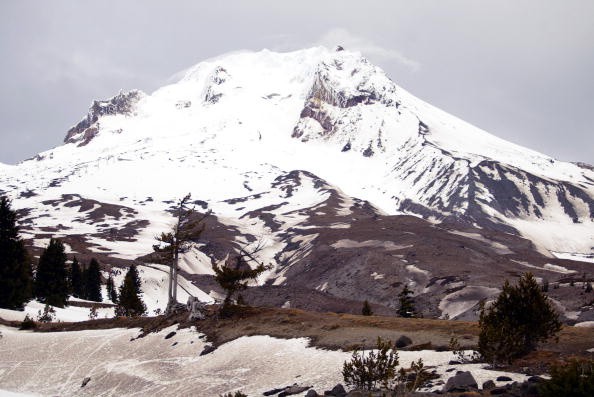While southern California keeps rattling and shaking from an earthquake swarm that's produced over 1,000 earthquakes over the last 7 days, a new swarm is now impacting the largest volcano in Oregon: Mount Hood.

Mount Hood
In the last week, 67 earthquakes have hit the southern flank of the stratovolcano. Among all the earthquakes, the most powerful was a 3.9 which struck not too long before 9 pm last night.The U.S. Geological Survey's (USGS) Cascades Volcano Observatory (CVO) monitors volcanoes in Oregon, Washington, and Idaho.
While they've grouped Mount Hood as a "very high threat potential", CVO has not altered the volcano alert level nor the volcano's aviation color code. As such, the current volcano alert level is just "NORMAL" and the aviation color code is "GREEN."
CVO wrote in a statement concerning the 3.9 earthquake and the general swarm: "The swarm was preceded by some earthquakes in the hour before the M 3.9, and tens of aftershocks have taken place with event rates decreasing in a fashion typical of mainshock-aftershock sequences.
"The mainshock features and location are consistent with previous swarms in the Mount Hood area, including a M 4.5 on June 29, 2002, that was sited ~1 mile east of the M 3.9. Aftershocks will possibly persist for hours or even days, some of which may be felt."
Also Read: Earthquake Swarm Near San Andreas Fault, California at Big Quake Risk This Week
Earthquake Swarm
CVO said at this time, seismologists at the Cascades Volcano Observatory and Pacific Northwest Seismic Network do not believe this swarm means a change in volcanic hazard at Mount Hood, but will keep monitoring the swarm and will issue more updates as the circumstance warrants.
According to the USGS, an earthquake swarm is a sequence of mainly small earthquakes with no recognizable mainshock. Swarms are often short-lived, but they can persist for days, weeks, or at times even months. They constantly recur at particular locations. Most swarms are linked with geothermal activity. Swarms are often not tied to aftershocks.

Aftershocks
Aftershocks are a sequence of earthquakes that take place after a greater mainshock on a fault.
Aftershocks take place close to the fault zone where the mainshock rupture takes place and are among the "readjustment process" after the major slip on the fault. With time, aftershocks become less recurrent, although they can persist for days, weeks, months, or even years for a very great mainshock. Mount Hood is the largest volcano in Oregon and the state's tallest mountain.
Devised by a subduction zone on the Pacific Coast in the Pacific Northwest, it's sited approximately 50 miles east-southeast of Portland. Mount Hood stands a tall 1,240 feet high; the high elevation is an abode to 12 named glaciers and snowfields. While USGS identified the volcano as "potentially active", the mountain is regarded informally dormant for now.
Related Article : 20,000 Swarms of Earthquakes Could Cause Volcanic Eruptions in Iceland, Experts Say
For more news, updates about earthquake swarm and similar topics don't forget to follow Nature World News!
© 2025 NatureWorldNews.com All rights reserved. Do not reproduce without permission.





